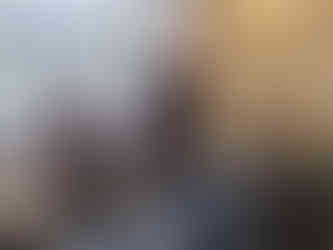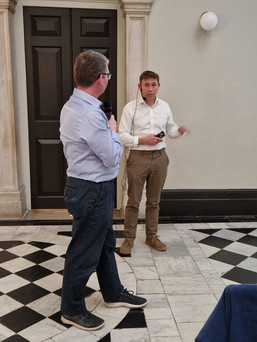Kilonovae and high energy explosions - multi-messenger astronomy, by Professor Stephen Smartt
- Mike Meynell
- May 13, 2024
- 4 min read
Updated: May 15, 2024
The Flamsteed Astronomy Society hosted an engaging evening at Queen's House that began with a news roundup by committee member Paul May, followed by a captivating lecture from Professor Stephen Smartt. The night was filled with insights into both the latest astronomical discoveries and the exciting future of multi-messenger astronomy.
Before the main event, Flamsteed committee member Paul May treated the audience to a delightful and eclectic mix of recent astronomy news. Kicking things off with the iconic Voyager probes, Paul shared updates on these intrepid explorers. Launched in 1977, Voyager 1 and Voyager 2 have been boldly going where no probe has gone before for 47 years. Voyager 1 recently had a bit of a senior moment, sending back random ones and zeros, but the tech wizards at JPL worked their magic and fixed it remotely. These spacecraft, which still carry some of the oldest running computers, continue to send valuable data from beyond the heliosphere.

Paul then moved on to the dazzling discovery of the universe’s most luminous quasar, which had been hiding in plain sight. Originally mistaken for a star in our galaxy, this quasar is actually 10 billion light-years away. Identified using the Very Large Telescope in Chile, it’s a massive black hole with a blazing accretion disk. Fun fact: the telescope's nearby hotel, featured in the James Bond film "Quantum of Solace," adds a touch of Hollywood glamour to the world of professional astronomy.
In a nod to our ever-increasing space traffic, Paul highlighted the proliferation of space debris orbiting Earth. Using a nifty website called AstriaGraph, he illustrated the cluttered state of our planet’s orbital neighbourhood. With 10,000 operational satellites and half a million pieces of space junk larger than a centimetre, it’s getting crowded up there. But at least Elon Musk's rocket bodies return to Earth, which is a small win in the battle against orbital junk.
Paul wrapped up with a timely report on the recent solar activity from sunspot AR 3664, which led to spectacular auroras lighting up the sky. The sunspot, similar in size to that seen during the Carrington Event over 150 years ago, caused quite a stir and had everyone brushing up on their space weather terminology.
Professor Stephen Smartt's lecture at the Flamsteed Astronomy Society offered a fascinating look into supernovae, kilonovae, and the exciting field of multi-messenger astronomy. Kicking off with a personal anecdote about his growth as a public speaker, Stephen mentioned that Queen’s House was possibly the best venue that he’d ever given a public talk in!

He began with a historical tour of supernova observations, starting with the 1885 “nova” in the Andromeda Galaxy, supposedly discovered by Ernst Hartwig. Initially misunderstood, this event was later reinterpreted as a supernova, thanks to advancements in astronomical knowledge. Stephen shared a lesser-known story about Isaac Ward, an observer from Belfast who spotted the same nova a day before Ernst Hartwig but didn't make a fuss about it. Lesson learned: always share your discoveries! The next supernova discovered from the island of Ireland was in 2010 by Dave Grennan in Rahenny, Dublin; which Stephen managed to produce a spectrum of.
Stephen explained neutron stars and black holes, describing them as the universe's densest objects. Neutron stars, he noted, pack an unimaginable amount of mass into a tiny space, while black holes are even denser and have gravitational pulls so strong that not even light can escape. These objects are crucial for generating gravitational waves, a concept predicted by Einstein, who doubted they'd ever be detected due to their subtlety. Well, take that, Einstein!

The lecture's highlight was the 2017 detection of gravitational waves from a neutron star merger by LIGO and Virgo detectors, accompanied by electromagnetic radiation. This event, GW170817, was a landmark in multi-messenger astronomy, providing key insights into the creation of heavy elements like gold and platinum.
Since 2017, only one other binary neutron star merger with an optical counterpart has been observed, highlighting the rarity and challenges of detecting these events. Kilonovae, the explosive results of neutron star mergers, are particularly tricky to spot because they're faint, fade quickly, and don't happen often. It's like finding a cosmic needle in a haystack.
Looking ahead, Stephen expressed excitement about the Rubin Observatory, under construction in Chile. This state-of-the-art facility, with its massive aperture and advanced capabilities, promises to enhance the detection rate of kilonovae and other transient phenomena.
Stephen emphasized the importance of combining data from different observational methods to improve detection and analysis. Gravitational wave detectors provide precise timing, while electromagnetic observations offer accurate positional data. This tag-team approach is crucial for advancing multi-messenger astronomy.
He also discussed the role of machine learning and data processing in handling the vast amounts of data generated by modern observatories. For example, the Rubin Observatory is expected to detect around 10 million sources per night. That's a lot of cosmic selfies to sift through, necessitating advanced algorithms to identify and classify significant events.

One of the most exciting prospects is the potential of multi-messenger astronomy to answer fundamental questions about the universe. Understanding the processes that produce heavy elements, determining the maximum mass of neutron stars, and probing the nature of black holes are all within reach. These observations could also refine measurements of the Hubble constant, helping us better understand the universe's expansion.
Stephen wrapped up his lecture with an optimistic outlook for the future. He emphasized the collaborative nature of modern astronomy, where scientists worldwide work together, pooling their resources and expertise to tackle the biggest questions. He expressed confidence that technological advancements and improved observational techniques would lead to significant discoveries in the next decade.
The lecture left the audience with a deeper appreciation for the complexities and opportunities in multi-messenger astronomy. Professor Smartt's engaging storytelling and clear explanations provided valuable insights into the current state and future potential of this exciting field, making for an entertaining and enlightening evening.
Our thanks to Professor Stephen Smartt for taking the time to come and speak to the Flamsteed. We hope to see him again in the future when the data from the Rubin Observatory starts to flow in!
























Comments